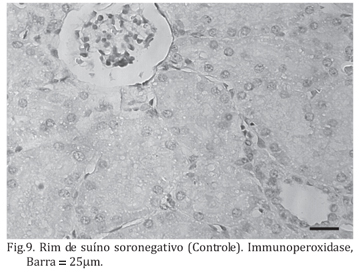Serum and kidney of 75 mixed bred swine (no definite breed) reared in an extensive system and slaughtered in Timon (state of Maranhão) and Teresina (state of Piauí), Brazil, two cities separated from each other by the Parnaiba River, and 75 crossbred swine from a confinement rearing system, sired by Landrace, Large White and/or Duroc, were used in this study. From the 150 analyzed samples for the microscopic agglutination test (MAT), seven were reagents and the serovar Icterohaemorrhagiae (42.86%) was the most frequent. A comparison between both systems to verify a predisposition to Leptospira spp. infection showed that susceptibility was greater in extensively reared animals than in those bred in confinement (χ2 test, p<0.05). Inflammatory infiltrates covered an average area larger in the seropositive revealing a significant difference for the seronegative animals (p<0.05, Mann-Whitney U-Test). Morphometric analysis showed Leptospira spp. and antigen labeling in seropositive animals only (p<0.05, Mann-Whitney U-test). Apoptosis in tubular epithelial cells was significantly more evident in the infected animals compared to uninfected. The rearing system and environment conditions are an important factor in the susceptibility of swine to Leptospira spp. infection. An eventual association of leptospira antigen and apoptotic cells suggests a probable mechanism of renal injury at leptospirosis.
Leptospirosis; immunohistochemistry; kidney; swine









